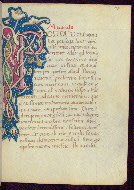Home > Digitized Walters Manuscripts
This document is a tranformation of a TEI P5 XML manuscript description incorporating images. If you have trouble reading special or non-Latin characters on this page, please make sure you have appropriate Unicode fonts installed and an up-to-date web browser.
Walters Ms. W.393, Rufus Festus, Breviarium Rerum Gestarum Populi Romani; Pseudo-Aurelius Victor (?), De Viris Illustribus; Ludovico Foscarini, Gesta Victoris et Coronae
Browse images (Browse images in a new window) | TEI in XML format
W.393
Rufus Festus, Breviarium Rerum Gestarum Populi Romani; Pseudo-Aurelius Victor (?), De Viris Illustribus; Ludovico Foscarini, Gesta Victoris et Coronae
Authority name: Festus, Rufus
As-written name: Ruffus Sextus
Known as: Sextus Rufus
Authority name: Pseudo-Aurelius Victor
As-written name: Pliny Veronesis
Authority name: Ludovico Foscarini
As-written name: Ludovicus Foscarenus
Known as: Ludovico Foscarini
Known as: Ludovici Foscareni
Written in the fifteenth century, perhaps ca. 1450-1460 in Venice, this manuscript contains works by Rufus Festus, Pseudo-Aurelius Victor, and Ludovico Foscarini. The first text, Breviarium Rerum Gestarum Populi Romani, is a purposefully brief history of the Roman Empire. The first half describes Rome's acquisition of its provinces in chronological order, while the second half is an account of Rome's wars with Persia. It was written in 370 CE for the Emperor Valens (r. 364 to 378 CE), who ruled the Eastern Roman Empire while his brother Valentinian I (r. 364 to 375 CE) ruled the West. In the rubric and incipit of the Walters' manuscript, Festus is erroneously named Ruffus Sextus, which stems from an early corruption of "Festus" to "Sextus." In addition, Valens is named Valentinian, confusing one brother for another. The second text, De Viris Illustribus, also concerns the history of the Roman Empire and dates to the fourth century CE. It gives short, concise biographies of important men from Rome's long history. It is one of many such texts that fall within the genre of Roman exemplary literature, the most famous of which is Suetonius' early second century CE work "De Vita Caesarum" or “The Lives of the Caesars.” In the manuscript tradition, the author of De Viris Illustribus has been given as both Pliny Secundus Veronesis, otherwise known as Pliny the Younger, who was writing in the late first century CE, or as Aurelius Victor, a fourth century CE historian. The Walters text adopts the former, naming the author as "Pliny Veronesis." Most scholars have dismissed both Pliny and Aurelius Victor as potential authors, and instead prefer to say he was a late antique scholarly commentator working in the fourth-early fifth century CE. The third text is an account of the lives of Victor and Corona, two Christian martyrs that were killed during the Roman Empire. According to its 1439 dedicatory letter, the text was written by Venetian humanist Ludovico Foscarini (1409-1480) and dedicated to Jacopo Foscaro (ca. 1416-1457), the son of the 65th Venetian Doge Francesco Foscari. In 1439 Jacopo was serving as praetor of Feltre, a small city and commune outside of Venice, whose patron saints are Victor and Corona. On fol. 65r, the beginning of the dedicatory letter, is depicted heraldry that likely represents the noble Giustiniani family of Venice. The text was written during the lifetime of Bernardo Giustiniani (1408–1489), a prominent Venetian senator and diplomat who was also an avid historian interested in the Roman Empire. His close friendship with Ludovico Foscarini suggests that it was perhaps Bernardo who commissioned the production of the Walters manuscript.
Second half of 15th century CE
Venice (?), Italy
Book
Historical
Literary -- Prose
The primary language in this manuscript is Latin.
Parchment
Likely evidence of cropping for the new binding on fol. 1r; pastedowns and flyleaves composed of modern parchment
Foliation: iii+94+iii
Modern pencil foliation, upper right and lower bottom right corners, rectos
Formula: iii + Quires 1-4: 10 (fols. 1-40); Quires 5-6: 12 (fols. 41-64), Quire 7-9:10 (fols. 42-94) + iii
Catchwords: In the first text, written in black ink on center of bottom versos (as on fol. 10v); in the second and third texts, written in black ink vertically on right bottom corner versos (as on fol. 30v)
Comments:
10.2 cm wide by 14.4 cm high
6.1 cm wide by 9.2 cm high
- Columns: 1
- Ruled lines: 20
- First line of text above ruling
- Title: Collection of texts by Rufus Festus, Pseudo-Aurelius Victor (?), and Ludovico Foscarini
- Hand note: Written in humanist script; the same hand for all three texts
- Decoration note: White-vine initials (fols. 1r, 65r, 78r); heraldry of the Giustiniani family(?) (fol. 65r); decorated initial (fol. 66r); historiated initial (fol. 68v); rubrics in red ink; text in black ink; also in red ink: text divisions in the second text and the names "Sebastianus" and "Victor" in the first part of the third text
- Title: Breviarium Rerum Gestarum Populi Romani
- Author: Festus, Rufus
- Rubric: Ruffi Sexti viri consularis rerum gestarum populi romani Valentiniano augusto liber incipit
- Incipit: Pio Perpetuo Valentiniano imperatori(?) et semper augusto Ruffus Sextus consularis vir consularis
- Contents: Brief history of Rome written for the emperor Valens by Rufus Festus ca. 370 CE
- Title: De Viris Illustribus
- Author: Pseudo-Aurelius Victor
- Rubric: Pliny Veronesis opus de viris illustribus foeliciter incipit
- Incipit: Proca rex albanorum, amulium et numitorem filios habuit
- Contents: Text detailing the lives of illustrious Romans
- Title: Dedicatory letter for Gesta Martyrium Victoris et Coronae
- Author: Ludovico Foscarini
- Incipit: Ludovicus foscarenus artium ac viris utriusque doctor clarissimo Jaco Foscaro salutatem
- Contents: Dedicatory letter from Ludovico Foscarini to Jacopo Foscaro dated 1439
- Title: Prologue to Gesta Martyrium Victoris et Coronae
- Author: Ludovico Foscarini
- Rubric: Ludovici Foscareni patrici veneti artii ac juris utriusque interpretis gesta gloriosorum martirum Victoris ac Coronae ad virum illustrem Jacobum Foscarum
- Incipit: Permulti sunt non solum comunes sed graves etiam
- Contents: Preface to Gesta Victoris et Coronae
- Title: Gesta Martyrium Victoris et Coronae
- Author: Ludovico Foscarini
- Rubric: Martirium
- Incipit: Imperante Antonio dedit editum Sebastiano eius exercitum in cicilia
fol. 1r:
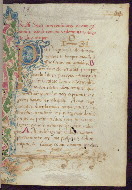
- Title: Decorated initial "P"
- Form: Decorated initial "P," 8 lines
- Text: Beginning of Rufus Festus' Breviarium Rerum Gestarum Populi Romani
fol. 65r:
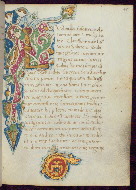
- Title: Decorated initial "L" and Giustiniani heraldry
- Form: Decorated initial "L," 7 lines, with medallion of Giustiniani heraldry
- Text: Beginning of Ludovico Foscarini's dedicatory letter to Jacopo Foscaro
- Label: This page depicts a decorated initial "D" with the Giustiniani heraldry in the form of a gold double-headed eagle on red ground, the medallion encircled by a dog(?)
- Comment:
The heraldry has been identified as belonging to the Giustiniani family of Venice, whose members held various positions of power in the city from the fifteenth through the seventeenth centuries.
fol. 66r:
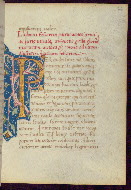
- Title: Decorated initial "P"
- Form: Decorated initial "P," 10 lines
- Text: Prologue to Ludovico Foscarini's Gesta Victoris et Coronae
fol. 68v:
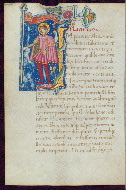
- Title: Historiated initial "I" with the martyr Victor
- Form: Historiated initial "I," 10 lines
- Text: The beginning of Ludovico Foscarini's Gesta Martyrium Victoris et Coronae
- Label: This page contains a historiated initial "I" that depicts a nimbed male figure, most likely Victor, whose story is recounted in the text.
fol. 78r:
The binding is not original.
Bound in London, England by Leighton between 1896 and ca. 1912 based on an inscription on the inner board that reads "Leighton Brewer St W."; brown Morocco leather with blind gold tooling in the form of rectangular frames; Leighton added a binion of parchment before and after the fifteenth-century parchment
Created second half of the fifteenth century, Venice(?), Italy perhaps for the Giustiniani family based on the heraldry found on fol. 65r
Marchese Campana sale (London, 20 July 1860, no. 244) to Boone, for Sir Thomas Phillipps, England (no. 18094 in his collection)
Quartich Booksellers, London, 1896 (published in their catalog 164, no. 147), purchased from sale of Sir Thomas Phillips' estate (London, 1896, no. 999)
Leo S. Olschki, bookseller, Florence, before 1912
Henry Walters, Baltimore, purchased from Leo S. Olschki ca. 1912 (list no. 9, inv. no 5813)
Walters Art Museum, 1931, by Henry Walters' bequest
De Ricci, Seymour. Census of Medieval and Renaissance Manuscripts in the United States and Canada. Vol. 1. New York: H. W. Wilson Company, 1935, p. 838, no. 472.
Eadie, John William. The Brevarium of Festus; a critical edition with historical commentary. London: Athlone Press. 1967, p. 26.
Labalme, Patricia H. Bernardo Giustiniani: a Venetian of the Quattrocento. Roma: Edizioni di storia e letteratura, 1969.
Sherwin Jr., Walter K. "De Viris Illustribus: Two Unexamined MSS in the Walters Art Gallery." Classical World 65, no. 5 (1972): 145-146.
Sage, Michael M. "The 'De Viris Illustribus' Authorship and Date." Hermes 108 (1980): 83-100.
Frazier, Alison Knowles. Possible lives: authors and saints in renaissance Italy. New York: Columbia University Press. 2005, p.xxii, plate 1; p. 387.
Kelly, Gavin. "The Roman World of Festus' Breviarium." In Unclassical Traditions, Volume 1: Alternatives to the Classical Past in Late Antiquity, edited by Christopher Kelly et al. Cambridge: Cambridge Philological Society, 2010, p. 72-91.
Principal cataloger: Berlin, Nicole
Cataloger: Walters Art Museum curatorial staff and researchers since 1934
Editor: Herbert, Lynley
Copy editor: Dibble, Charles
Conservators: Polidori, Elisabetta; Quandt, Abigail
Contributors: Emery, Doug; Tabritha, Ariel; Vinson, Aubrey; Wiegand, Kimber
The Walters Art Museum
Licensed for use under Creative Commons Attribution-ShareAlike 3.0 Unported Access Rights, http://creativecommons.org/licenses/by-sa/3.0/legalcode. It is requested that copies of any published articles based on the information in this data set be sent to the curator of manuscripts, The Walters Art Museum, 600 North Charles Street, Baltimore MD 21201.
